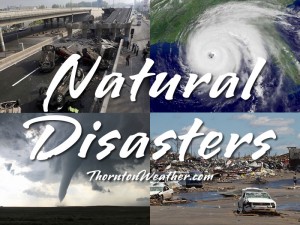
According to the National Climatic Data Center (NCDC), the U.S. has seen a record number of billion dollar disasters in 2011. Thus far this year the nation has seen 10 such disasters and with hurricane season far from over, it seems likely the number will grow.
The events range from the Groundhog Day Blizzard to Hurricane Irene’s recent devastating blow to the East Coast. In all, the disasters represent more than $35 billion in losses and that is no including Irene’s yet to be determined toll.
Below is the list and narrative for each disaster from the NCDC. For the latest disaster news, be sure to check out the Natural Disasters Examiner.
Hurricane Irene, August 20-29, 2011 While it will take several months to determine an accurate estimate of the damage from Hurricane Irene, there is no question it will rank as the 10th billion-dollar weather event of the year. This 10th U.S. billion-dollar disaster officially breaks the annual record dating back to 1980.
Upper Midwest Flooding, Summer, 2011 Melting of an above-average snow pack across the Northern Rocky Mountains combined with above-average precipitation caused the Missouri and Souris Rivers to swell beyond their banks across the Upper Midwest (MT, ND, SD, NE, IA, KS, MO). An estimated 11,000 people were forced to evacuate Minot, North Dakota due to the record high water level of the Souris River, where 4,000 homes were flooded. Numerous levees were breached along the Missouri River, flooding thousands of acres of farmland. Estimated losses exceed $2.0 billion as the event continues to unfold (as of 8/15). The flooding also stretched into the Canadian Prairies, where property and agriculture losses were expected to surpass $1.0 billion, at least 5 deaths.
Mississippi River flooding, Spring-Summer, 2011 Persistent rainfall (nearly 300 percent normal precipitation amounts in the Ohio Valley) combined with melting snowpack caused historical flooding along the Mississippi River and its tributaries. Estimated economic loss ranges from $2.0-4.0 billion; at least 2 deaths. Below are more detailed stats, which are preliminary, as the event continues to unfold (as of 8/15): $500 million to agriculture in Arkansas; $320 million in damage to Memphis, Tennessee; $800 million to agriculture in Mississippi; $317 million to agriculture and property in Missouri’s Birds Point-New Madrid Spillway; $80 million for the first 30 days of flood fighting efforts in Louisiana.
Southern Plains/Southwest Drought, Heatwave, & Wildfires, Spring-Summer, 2011 Drought, heatwave, and wildfires have created major impacts across the Texas, Oklahoma, New Mexico, Arizona, southern Kansas, and western Arkansas and Louisiana. In Texas and Oklahoma, respectively, 75% and 63% of range and pasture conditions were classified in ‘very poor’ condition as of mid-August. Wildfire fighting/suppression costs for the region are also ~$1 million / day with over 2,000 homes and structures lost. The total direct losses (as of August 15) to agriculture, cattle and structures are well over $5.0 billion; both direct and total economic losses will rise dramatically as the event continues.
Midwest/Southeast Tornadoes, May 22-27, 2011 Outbreak of tornadoes over central and southern states (MO, TX, OK, KS, AR, GA, TN, VA, KY, IN, IL, OH, WI, MN, PA) with an estimated 180 tornadoes and 177 deaths. Notably, an EF-5 tornado struck Joplin, MO resulting in at least 141 deaths, making it the deadliest single tornado to strike the U.S. since modern tornado record keeping began in 1950. Over $4.9 billion insured losses for event; total losses greater than $7.0 billion; 177 deaths.
Southeast/Ohio Valley/Midwest Tornadoes, April 25-30, 2011 Outbreak of tornadoes over central and southern states (AL, AR, LA, MS, GA, TN, VA, KY, IL, MO, OH, TX, OK) with an estimated 305 tornadoes and 327 deaths. Of those fatalities, 240 occurred in Alabama. The deadliest tornado of the outbreak, an EF-5, hit northern Alabama, killing 78 people. Several major metropolitan areas were directly impacted by strong tornadoes including Tuscaloosa, Birmingham, and Huntsville in Alabama and Chattanooga, Tennessee, causing the estimated damage costs to soar. Over $6.6 billion insured losses; total losses greater than $9.0 billion; 327 deaths.
Midwest/Southeast Tornadoes, April 14-16, 2011 Outbreak of tornadoes over central and southern states (OK, TX, AR, MS, AL, GA, NC, SC, VA, PA) with an estimated 160 tornadoes. Despite the large overall number of tornadoes, few were classified as intense, with just 14 EF-3, and no EF-4 or EF-5 tornadoes identified. Over $1.4 billion insured losses; total losses greater than $2.0 billion; 38 deaths [22 of which were in North Carolina].
Southeast/Midwest Tornadoes, April 8-11, 2011 Outbreak of tornadoes over central and southern states (NC, SC, TN, AL, TX, OK, KS, IA, WI) with an estimated 59 tornadoes. Over $1.5 billion insured losses; total losses greater than $2.2 billion; numerous injuries, 0 deaths.
Midwest/Southeast Tornadoes, April 4-5, 2011 Outbreak of tornadoes over central and southern states (KS, MO, IA, IL, WI, KY, GA, TN, NC, SC) with an estimated 46 tornadoes. Over $1.6 billion insured losses; total losses greater than $2.3 billion; 9 deaths.
Groundhog Day Blizzard, Jan 29-Feb 3, 2011 Large winter storm impacting many central, eastern and northeastern states. The city of Chicago was brought to a virtual standstill as between 1 and 2 feet of snow fell over the area. Insured losses greater than $1.1 billion; total losses greater than $2.0 billion; 36 deaths.
